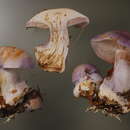Associations
provided by BioImages, the virtual fieldguide, UK
In Great Britain and/or Ireland:
Foodplant / mycorrhiza / ectomycorrhiza
fruitbody of Cortinarius caerulescens is ectomycorrhizal with live root of Fagus
Remarks: Other: uncertain
Comprehensive Description
provided by North American Flora
Cortinarius caerulescens Fries; Maire, Bull. Soc. Myc. Fr
27:424. 1912.
Cortinarius caerulescens Fries, Bpicr. Myc. 265, in part. 1838.
Pileus fleshy, convex, then convex-plane, quite thick, 3-6 cm. broad; surface with a separable, viscid pellicle, glabrous, even, violaceous-blue, ochraceous-tinged on the disk, sometimes entirely ochraceous-yellow, not hygrophanous, the margin at first incurved, pubescent and white, then spreading and violaceous; context paleviolaceous-blue, especially under the cuticle, then whitish, at length ochraceous-stained, the odor slight, the taste mild; lamellae arcuate, then plane or slightly ventricose, attenuate in front, rounded behind, thin, broad, rather broadly adnate, violet-amethyst or violet-blue at first, then rusty-brown, the edge serratulate; stipe cylindric-conic, 3-5 cm. long, 10 mm. thick, with a marginate bulb, fibrous-fleshy, dry, silky-fibrillose, violaceous-blue to amethyst-blue, the bulb white, solid; cortina violaceous at first; universal veil rapidly evanescent; spores subamygdaliform, ellipsoid, tuberculate, 12-14
X 6-7 /x.
Type locality: Sweden. Habitat: In coniferous and mixed forests. Distribution: Tennessee; also in Europe.
- bibliographic citation
- William Alphonso Murrill, Lee Oras Overholts, Calvin Henry Kauffman. 1932. (AGARICALES); AGARICACEAE (pars); AGARICEAE (pars), HYPODENDRUM, CORTINARIUS. North American flora. vol 10(5). New York Botanical Garden, New York, NY
Comprehensive Description
provided by North American Flora
Cortinarius caesiocyaneus Britz. Bot. Centr. 62: 307, in part
1895; 80: 58, in part. 1899; Maire, Bull. Soc. Myc. Fr.
26: 176. 1910.
Pileus fleshy, convex, then expanded-plane, sometimes depressed in the center, 5-12 cm. broad; surface bluish-violaceouswhite to silvery-violaceous, glabrous, even, with a viscid, separable pellicle, silky-shining when dry, the margin becoming silky and at first incurved; context pale-violet, fading slowly, thick, the odor and taste mild; lamellae rather narrow, adnexed, rounded behind then sinuate, thin, pale-violaceous, soon pale-alutaceous, then cinnamon, crowded, the edge even or becoming eroded; stipe stout, 4-7 cm. long, 1-2 cm. thick, solid, pale-violaceous-white, concolorous within, equal above the large, flattened, marginatedepressed bulb, the bulb white on the surface from the white universal veil, attached to white mycelium; cortina violaceous-white; spores almond-shaped, ellipsoid, tuberculate, 10-12 (rarely 13) X 6-7 m, cinnamon in mass.
Type locality: Bavaria, Germany.
Habitat: In frondose or coniferous woods, on the ground among fallen leaves. Distribution: Northeastern North America to Missouri; Colorado; California.
- bibliographic citation
- William Alphonso Murrill, Lee Oras Overholts, Calvin Henry Kauffman. 1932. (AGARICALES); AGARICACEAE (pars); AGARICEAE (pars), HYPODENDRUM, CORTINARIUS. North American flora. vol 10(5). New York Botanical Garden, New York, NY

